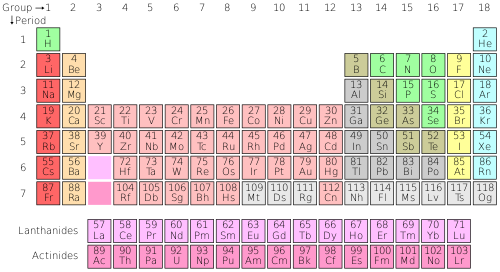 The Spitzer space telescope has snapped a striking false-colour image of the RCW 120 nebula, a vast cloud of gas and dust where stars have recently formed.
The Spitzer space telescope has snapped a striking false-colour image of the RCW 120 nebula, a vast cloud of gas and dust where stars have recently formed.
RCW 120 lies about 4,300 light-years away in the constellation Scorpius, just above the plane of the galaxy. It emits a broad range of colours in the infrared region, with wavelengths far beyond those we can see.
Spitzer telescope snaps stunning image of 'ring' nebula
2 new elements officially added to periodic table
 Remember the periodic table from high school chemistry? It just got a little bigger. Two new chemical elements, numbers 114 and 116, have been officially recognized by an international committee of chemists and physicists.
Remember the periodic table from high school chemistry? It just got a little bigger. Two new chemical elements, numbers 114 and 116, have been officially recognized by an international committee of chemists and physicists.
The elements last for less than a second and join such familiar neighbors as carbon, gold, tin and zinc. The new ones don't have approved names yet. That brings the total of known elements to just 114 because elements 113 and 115 haven't been officially accepted yet, said Paul Karol of Carnegie Mellon University.
Surprise find in Kepler planet hunt: lots of multi-planet systems
 NASA's Kepler spacecraft, which is searching for Earth-mass planets orbiting sun-like stars, is finding hundreds of candidate planets, and many more multi-planet systems than expected.
NASA's Kepler spacecraft, which is searching for Earth-mass planets orbiting sun-like stars, is finding hundreds of candidate planets, and many more multi-planet systems than expected.
Two years into a 3-1/2-year mission, NASA’s Kepler spacecraft, hunting for planets orbiting some 165,000 stars in the constellation Cygnus, is uncovering planet candidates by the hundreds.
Many of these inhabit multi-planet systems that are unexpectedly flat – the inclination of the planets’ orbits within each of these systems are essentially the same, a feature that may hold clues about how these systems formed and evolved.
Fukushima's Apocalyptic Threat Demands Immediate Global Action
 Fukushima may be in an apocalyptic downward spiral.
Fukushima may be in an apocalyptic downward spiral.
Forget the corporate-induced media coma that says otherwise…or nothing at all.
Lethal radiation is spewing unabated. Emission levels could seriously escalate. There is no end in sight. The potential is many times worse than Chernobyl.
Scientists investigate twisters as crime-scene detectives
 Weather scientists are retracing the footprints of this week's monstrous tornadoes the way detectives would investigate a crime scene: talking to witnesses, watching surveillance video and taking the measurements of trees ripped from the ground.
Weather scientists are retracing the footprints of this week's monstrous tornadoes the way detectives would investigate a crime scene: talking to witnesses, watching surveillance video and taking the measurements of trees ripped from the ground.
The result will be a meteorological autopsy report on the disaster, revealing how many twisters developed and how powerful they were.
Shrinking funds pull plug on alien search devices
 In the mountains of Northern California, a field of radio dishes that look like giant dinner plates waited for years for the first call from intelligent life among the stars. But they're not listening anymore.
In the mountains of Northern California, a field of radio dishes that look like giant dinner plates waited for years for the first call from intelligent life among the stars. But they're not listening anymore.
Cash-strapped governments, it seems, can no longer pay the interstellar phone bill. Astronomers at the SETI Institute said a steep drop in state and federal funds has forced the shutdown of the Allen Telescope Array, a powerful tool in the search for extraterrestrial intelligence, an effort scientists refer to as SETI.
Dry ice lake suggests Mars once had a ‘Dust Bowl’
 Mars today has a brutal environment — frigid, arid and, because of its very thin atmosphere, constantly bombarded by lethal radiation. But it was worse 600,000 years ago, according to new research that suggests the planet had a far dustier, stormier atmosphere.
Mars today has a brutal environment — frigid, arid and, because of its very thin atmosphere, constantly bombarded by lethal radiation. But it was worse 600,000 years ago, according to new research that suggests the planet had a far dustier, stormier atmosphere.
“It was an unpleasant place to hang out,” said lead researcher Roger Phillips of the Southwest Research Institute in Boulder, Colo.
More Articles...
Page 40 of 61

 Science Glance
Science Glance






























